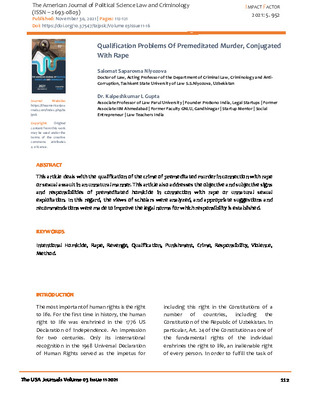Qualification Problems Of Premeditated Murder, Conjugated With Rape
Abstract
This article deals with the qualification of the crime of premeditated murder in connection with rape or sexual assault in an unnatural manner. This article also addresses the objective and subjective signs and responsibilities of premeditated homicide in connection with rape or unnatural sexual exploitation. In this regard, the views of scholars were analyzed, and appropriate suggestions and recommendations were made to improve the legal norms for which responsibility is established.

Downloads
Doctor of Law, Acting Professor of the Department of Criminal Law, Criminology and Anti-Corruption
Associate Professor of Law | Founder ProBono India, Legal Startups | Former Associate IIM Ahmedabad | Former Faculty GNLU, Gandhinagar | Startup Mentor | Social Entrepreneur | Law Teachers India
-
Criminological characteristics of the personality of the person who committed a crime in the family
The American Journal of Political Science Law and Criminology: No. 05 (2022) / Salomat Niyozova,
-
Considerations For The Prevention Of Crimes Against The Sexual Integrity Of Minors
The American Journal of Political Science Law and Criminology: No. 05 (2021) / Salomat Niyozova, Ravinder Kumar ,

Keywords:
Abstract
This article deals with the qualification of the crime of premeditated murder in connection with rape or sexual assault in an unnatural manner. This article also addresses the objective and subjective signs and responsibilities of premeditated homicide in connection with rape or unnatural sexual exploitation. In this regard, the views of scholars were analyzed, and appropriate suggestions and recommendations were made to improve the legal norms for which responsibility is established.
References
Krylova N., Safonov V. On the question of determining the moment of the end of a person's life in the criminal law of the Russian Federation. // J. Criminal law. 2010. – No.3. – P.54.
Jalolov J. Court tibbiyotidan terminologist malumotnoma. –T.: Med. ed. named after Abu Ali ibn Sino, 1995 .– p. 119.
S.V.Borodin Crimes against life. – M., Yurist, 1999. –p. 17.
Ivanyushkin A.Ya. Evolution of the concept of brain death in our country // Medical Law and Ethics. – 2003. –No. 1.– P.44.
Ivanyushkin A.Ya. Decree. op. – P.43.
S.V.Borodin. Qualification of crimes against life. – M., 1977. – p.16.
Saryev B. Responsibility for crimes against life and health. – Ashgabat, 1973. – p. 18.
Toxirov F.T. Crimes against the person and their legal analysis: Textbook. – Tashkent: Yangi asr avlodi, 2001. –B.5.
Soviet criminal law: A special part. Textbook. B.A. Akhmedov, B.A. Blinder, S.G. Zakutsky and others / Answer. editor: B.A. Akhmedov. – Tashkent: Ukituvchi ,. –B.53.
Criminal Law and Procedure Handbook of Illinois. Gould Publications. Inc. 1995. Specific Offenses. 5 / 9-2.1, – p. 252-253, 866.
Rustamboev M.H. Course of Criminal Law of the Republic of Uzbekistan. Volume 3. Crimes against the person. Crimes against peace and security. Textbook. 2nd edition, completed and revised. – Tashkent, Military Technical Institute of the National Guard of the Republic of Uzbekistan. 2018. – 29 b.
Toxirov F. Crimes against the person and their legal analysis: Textbook. - Tashkent: Yangi asr avlodi, 2001. –B.5.
Rustambaev M.Kh. Responsibility for sexual violence under the criminal law of Uzbekistan. –T .: TSUI, 2009 . – P. 97.
Afanasyev S.A., Ivanov V.I., Novik V.V. Features of investigations of sexual-sadistic murders. Tutorial. St. Petersburg, 1993. – p. 40.
Rustambaev M.Kh. Crimes against the person. Publishing house "Eldinur", Tashkent 1998. –p. 36.
Resolution of the Plenum of the Supreme Court of the Republic of Uzbekistan "On judicial practice in cases of premeditated murder" dated September 24, 2004, item 13. Collection of Resolutions of the Plenum of the Supreme Court of the Republic of Uzbekistan. T. II. –T.: Adolat, 2006. – P. 463.
Rustambaev M.Kh. Responsibility for sexual violence under the criminal law of Uzbekistan. –T .: TSUI, 2009. – P. 97.
Resolution of the Plenum of the Supreme Court of the Republic of Uzbekistan "On judicial practice in cases of premeditated murder" dated September 24, 2004, item 13. Collection of Resolutions of the Plenum of the Supreme Court of the Republic of Uzbekistan. T. II. –T.: Adolat, 2006. –P. 463.
In the same place. –T .: Adolat, 2006. – P.463.
Dzhekebaev U.S., Rakhimov T.G., Sudakova R.N. Motivation of crimes and criminal responsibility. –Alma-Ata: Science. 1987. –S.191.
Борзенков Г. Особенности квалификации убийства при конкуренции или сочетании различных квалифицирующих признаков // Уголовное право. 2007., –№ 5., – С. 7-11.
Rustambaev M.Kh., Krutko O.G. Responsibility for premeditated murder in aggravated circumstances on the basis of a subjective side. – Т .: ТГЮИ, 2006. – p.198-205.





